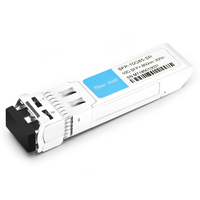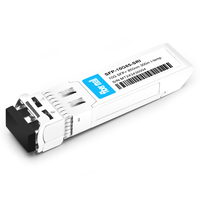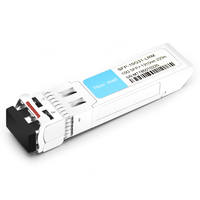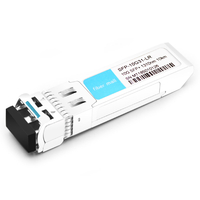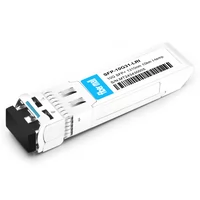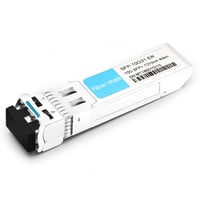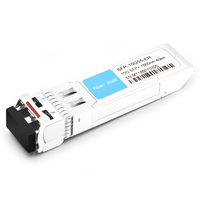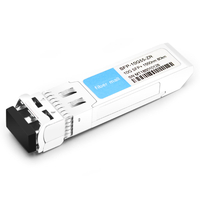In the digital world today, where everything is constantly changing, and businesses have to keep up to stay competitive, high-speed connections are made possible by twinax cables. 10GBASE-T network switches by Dell have become one of the essential elements in modern networking because of their outstanding performance and reliability and their cost-effective 10gbe switches for different types of networks. This article will try to give readers a complete understanding of Dell’s 10GBASE-T network switches; it will cover technical specifications, advantages, application scenarios, and some recommended deployment methods. Whether you are an IT professional who wants better connectivity or a business owner trying to improve your network system, this guide should offer helpful information to help guide decision-making on what kind of hardware would be best suited for the task.
Table of Contents
ToggleWhat is a Dell 10GBASE-T Network Switch?

Understanding the Basics of Dell Networking
A network switch with 10GBASE-T from Dell is a fast networking device for local area networks (LANs) to transfer data up to 10 Gbps through standard Ethernet cables (Cat6a or above). It supports 10GBASE-T technology, which means more bandwidth and better data transmission rates than ever – perfect for environments with lots of data flowing in and out. Low latency and high reliability are all buzzwords you’ll find when reading about these bad boys. And yes, please: seamless scalability! With Dell’s 10GBASE-T network switches, you can handle heavy network traffic loads without dropping packets or slowing down other parts of your infrastructure — this sounds like what every IT guy wants!
How Does a 10GBASE-T Switch Work in a Network?
A switch that is 10GBASE-T works by connecting many devices in a local area network (LAN) and sending data packets to their destinations at speeds of up to 10 Gbps through a robust gigabit ethernet switch framework. These switches transmit data using electrical signals over standard RJ-45 connectors and Ethernet cables (Cat6a or higher). Each port on the switch can handle high-speed communication between devices independently to ensure efficient traffic distribution, thereby reducing bottlenecks. The switch uses MAC (Media Access Control) addresses to identify devices on the network. It forwards data only to those recipient ports designated to optimize network performance and minimize latency. Additionally, Dell 10GBASE-T switches support advanced features like VLANs (Virtual Local Area Networks), quality of service (QoS), and link aggregation, further improving network management reliability.
Features of Dell EMC Powerswitch Models
Dell EMC PowerSwitch models are meant to provide advanced networking capabilities designed for different operational needs, which often require 1x qsfp for high-speed interconnects. Here are some of the key features:
- Scalability and High Performance: These switches have strong performance with multi-gigabit options and high-density ports that support different speeds, such as 1GbE, 10GbE, 25GbE, 40GbE, and 100GbE. This allows networks to scale appropriately to meet increasing data and bandwidth requirements.
- Advanced Security Features: Dell EMC PowerSwitch models include various security measures, such as access control lists (ACLs), port security, and secure management interfaces, to safeguard against unauthorized entry into the network or any possible threats.
- Programmability & Automation: The Power Switch series supports modern network programmability and automation standards. RESTful APIs and Ansible integration with OpenManage Network Manager (OMNM) make management easier while reducing operational inefficiency.
- Energy Efficiency: Designed using energy-efficient technologies that conform with Energy Efficient Ethernet standards, thus helping enterprises cut down on power consumption and cooling costs. They also come with dynamic power scaling capabilities.
- Resilience & Reliability: Dell EMC PowerSwitch models offer resiliency through redundancy features like hot-swappable power supplies/fans alongside advanced stacking abilities, ensuring uninterrupted network connectivity during downtimes.
- Virtualization Support: These switches boast strong virtualized environment support by integrating with VMware and Microsoft, among other leading platforms. They allow smooth deployment of virtualized applications/services using breakout options for flexible connections.
By including these advanced functionalities within them, Dell EMC Powerswitches provide organizations with the necessary tools for efficient network safety, which is characterized by high performance even under demanding conditions.
Why Choose a Dell 10GBASE-T Switch?

Advantages of Dell Networking Solutions
- Performance and Scalability: Dell networking solutions offer strong performance and scalability, as well as affordability, for modernizing infrastructures through 10gbe switches. Dell switches can process large amounts of data at high speeds and guarantee the smooth operation of enterprise applications with this virtualization support.
- Security and Reliability: To protect networks from intrusions or breaches, Dell Networking implements advanced security features such as port security or secure management interfaces. Additionally, they have been designed redundantly so that there is always another one working if something fails—this makes them highly reliable, too; even power supplies can be backed up with fans!
- Energy Efficiency: These energy-saving technologies built into Dell’s networking switch products help companies save electricity bills while taking care of nature. Such devices comply with Energy Efficient Ethernet (EEE) standards, which allow them to dynamically adjust consumed power according to the traffic loads within a network, thereby promoting overall environmental sustainability.
In conclusion, by utilizing these advantages described above, organizations can achieve effectiveness in terms of efficiency, safety, and sustainability in their networks because they will not only work better but also last longer without any downtime—thus making them ideal for businesses looking to improve their network performances.
Comparing Dell EMC to Other Brands like Cisco
A few things become noticeable when you compare Dell EMC to other major brands, such as Cisco. Although there are certain differences in their product portfolios, pricing, and support services, both companies offer high-performance switches designed for enterprise environments.
- Product Portfolio and Features: The primary difference between these two companies lies in their product range and features. Cisco is seen as an industry leader because it provides more advanced features, especially in routing and integrated security, among other things, which are not found on most competitors’ devices. This explains why Cisco’s catalysts or Nexus lines are known for being more sophisticated than any other brand. In contrast, Dell EMC has a limited number of options but has very effective ones that work well with its rest of enterprise solutions.
- Pricing and Cost-Effectiveness: If we consider the pricing aspect only, then Dell Networking is relatively cheaper than Cisco. However, one should keep in mind that this may be true because Cisco carries premium prices for its wide array of features and the reputation it holds so dear among different organizations worldwide. Therefore, if your company is a small-medium-sized business enterprise seeking strong performance without breaking the bank, look no further because Dell EMC will deliver just what you need at an affordable rate.
- Support and Customer Service: Regarding customer service support, both companies have their strong points. Cisco boasts extensive customer support services worldwide, including helpful documentation on how to get the most out of your device. Dell offers excellent customer service, too, but they focus more on giving personalized help, which can easily be applied in real-world situations so that they might lack some global presence compared to Cisco.
In summary, however, each organization must choose wisely based on their requirements, budget allotment, and desired feature set since these two giants each have merits; therefore, appropriate candidates should meet appropriate needs. Dell EMC provides a middle ground between affordability and ease of integration while Cisco provides breadth options with advanced features suitable for large-scale, highly specialized networks.
Cost-Effective Options: Refurbished Dell EMC Power switch
For those companies that need a dependable networking solution but don’t want to break the bank on brand-new equipment, there’s another option: Refurbished Dell EMC Power switches. These machines are put through strict tests and certifications to perform just as well as new ones. They’re also much cheaper. NetworkEquipment.net, Techbuyer, Dell Financial Services, and other top websites for buying used equipment all tout affordability as one of the main benefits of refurbished devices. However, they also talk about how they help save the environment by reducing electronic waste and being available immediately. In short, businesses can save lots of money without sacrificing network performance or sustainability – simply choose refurbished Dell EMC Powerswitches instead!
Which Dell 10GBASE-T Switch Models are Popular?

Overview of Dell EMC Powerswitch N4032
The Dell EMC Powerswitch N4032 is designed to give 10GbE communication with high performance, flexibility, and easy management in mind. According to top sites like Dell.com, NetworkEquipment.net, and CDW.com, the N4032 switch comes with 32 ports of 10GBASE-T and four SFP+ ports for more bandwidth and connectivity options. It supports Layer 2 and Layer 3 functionalities for robust security features such as network access control lists (ACLs), among others.
Additionally, this switch is best suited for contemporary data centers or enterprise networks that need traffic optimization and latency reduction capabilities. Furthermore, it supports advanced features like Energy Efficient Ethernet (EEE) or Dell EMC’s Open Networking initiative, enabling integration with third-party operating systems/applications for customized solutions. These unique attributes have made it one among many popular choices when scalability & cost-effective network infrastructure solutions are sought after by organizations.
Key Features of the Dell EMC S-Series Switches
The Dell EMC S-Series switches are made for the needs of enterprise networks and modern data centers. According to top websites like Dell.com, NetworkEquipment.net, and Techbuyer.com, these switches have a wide range of features that improve performance and flexibility while enhancing control.
- Versatility and High Port Density: The S-Series switches have 10GbE, 25GbE, 40GbE, or even 100GbE options in different port configurations, making them suitable for environments with many connectivity requirements.
- Support for Advanced Layer 2 and 3: These port network switches support both Layer 2 and three protocols robustly, enabling advanced switching and routing capabilities. They do this by using OSPF, BGP, and VLANs, among others, which enhance their roles.
- Efficiency in Energy: Energy-efficient Ethernet (EEE), along with its low power consumption feature, saves on operations costs while still maintaining the high-performance levels achieved by S-series switches.
- Open Networking: The S-Series from Dell EMC exemplifies open networking commitment since they can work well with applications or operating systems created by third parties. Therefore, businesses can have tailor-made network solutions that fit their needs.
- Resiliency and High Availability: For high availability purposes, the S series comes equipped with redundant power supplies plus hot-swappable fans that have advanced failover mechanisms built into them. This ensures the reliability of networks connected through these devices and that they do not suffer any downtime at all.
- Improved Security Features: Access Control Lists (ACLs) and SSH, among others, provide a robust security foundation against threats within networks guarded by port network switches belonging to Dell’s s-class family.
These notable attributes create demand among organizations seeking scalable infrastructure that is efficient and secure in terms of networking, thus making Dell EMC’s line-up, such as switch models starting with an s, highly preferred over other brands available today.
Specifications of 24 Port 10GBASE-T Switches
- Port Arrangement: 24 Port 10GBASE-T switches typically come with 24 x 10 Gigabit Ethernet ports, each of which can support fast network connections; these ports use standard RJ-45 connectors, making it easy to integrate them with existing cabling infrastructure.
- Capacity and Bandwidth: With an average switching capacity that exceeds 480Gbps throughputs and rates above 360 million packets per second (Mpps) for forwarding, such devices can handle large volumes of traffic without any problem within the network.
- Layer Support: These models, like any other high-end switch, offer full-fledged L2 and L3 protocol support for advanced functions such as VLAN, QoS, OSPF, BGP, and multicast routing, among others.
- Power over Ethernet (PoE): Some models can deliver power over ethernet, which means they can power up devices like IP cameras, VoIP phones, or wireless access points without the need for separate power supplies; they do so in accordance with PoE standards, PoE+ standards, and UPoE standards.
- Energy Efficiency and Cooling: Designed to be power efficient, this type of equipment adopts measures such as Energy Efficient Ethernet (EEE) coupled with advanced cooling methods, hence achieving the highest levels of reliability possible; also, hot-swappable fans alongside redundant power supplies guarantee continuous operation, thus minimizing downtime even in extreme conditions.
- Safety & Management: They feature more secure access control lists (ACLs), port security, SSH support, and superior logging mechanisms. They still support SNMP-based management, including RMON/Syslog capability, but they also allow for simple configuration through a Web-based GUI, which could be enclosed within rugged metal enclosures for increased durability.
- Quality Of Service (QoS): Advanced QoS provides options to prioritize critical traffic between different areas on a network by utilizing features such as traffic shaping/policing/priority queuing and congestion avoidance.
In summary, these features enable 24 Port 10GBASE-T switches to deliver higher performance levels with lower power consumption, thus making them suitable for use in demanding enterprise environments.
How to Install and Configure Dell 10GBASE-T Switches?

Step-by-Step Installation Guide
Opening the Box and Checking
Remove the switch from its box carefully and inspect for physical damage to the device and accessories. All listed components, such as mounting brackets and power cords, should be there.
Mounting on a Rack
Use screws to attach mounting brackets to the switch. Place it in the rack gently and fasten it securely. Make sure there is enough space around the unit for proper ventilation.
Power Connection
The supplied power cord connects the switch to an appropriate power source. If your model comes with redundant power supplies, ensure that both are connected to different power sources to increase reliability.
Setting Up for The First Time
Connect a computer to the management port of your Ethernet switch using an Ethernet cable. Configure this computer with a static IP address that falls within the same subnet as the switch’s default IP address (usually found in documentation).
Accessing Your Switch
On the web browser on the connected PC, enter the default IP address of that particular web-managed 10 GB Ethernet Switch and press the Enter or Return keys. You will be required to log in using the default credentials provided in the documentation, but it is advisable to change your password immediately after this for security reasons.
Configuration Network Setting
Go through the network settings section under web-based GUI; here, you can create VLANs, set up IP addresses, and define routing protocols where necessary, then save the configuration changes you make.
Connecting Devices
Start connecting all other devices into ports on gigabit ethernet switches one by one,, ensuring servers are linked via appropriate cables, workstations, and any other network appliances required.
Enabling PoE (If Necessary)
If your device supports PoE, connect PoE-powered devices like IP cameras or VoIP phones to ports explicitly marked as able to supply Power over Ethernet. Make sure correct PoE configurations have been done so that enough power is delivered to them.
Monitoring and Managing
Use provided management tools like SNMP, RMON, or web-based GUI to monitor performance and switch operation. Set up alerts and logging, which will help you stay updated on any critical events or possible problems that might occur within it.
Final Checks
Do a final check to ensure all devices are correctly connected and have received appropriate network settings. Test connectivity, then verify if everything is working as expected by ensuring the smooth running of the network.
By following these steps, your Dell 10GBASE-T switch should be installed and adequately configured for your network infrastructure’s best performance and reliability.
Configuring Dell Networking Interfaces
To set up the Dell networking interfaces, do as follows:
- Get into Management Interface: Sign in to the web-based GUI with the IP address and security details you received when setting it up first.
- Find Interfaces Section: Look for where the management interface displays tabs or sections relating to interfaces.
- Assign IP Addresses: Depending on your network’s needs, either assign each one of those static IPs or configure them as DHCP.
- Setup VLANs: Tag VLANs here and allocate interfaces to particular ones to divide traffic across networks efficiently.
- Link Aggregation: If more bandwidth and redundancy are desired, LAG should be configured by combining many links at the interface level.
- QoS Settings Should Be Applied: Set Quality of Service parameters to see critical services perform optimally while others are limited during congestion periods.
- Save Configuration: After completing all the required changes, don’t forget to save the configurations. Also, ensure they take effect even after restarting switches.
These steps are a quick reference guide when configuring Dell networking interfaces. They help with the proper segmentation of networks, better-managing traffic in them, and thus improving overall performance.
Setting Up Network Ports and VLANs
To optimally establish network ports and VLANs on the Dell 10GBASE-T switch, follow these professional and technical steps:
- Access the Management Interface: Sign in to the web-based GUI using the IP address provided with associated credentials.
- Go to Port Configuration Section: Find the port configuration or settings tab from within the management interface.
- Configure Port Modes: Every port should be set as access or trunk mode. Access mode connects ports with end devices, while trunk mode connects ports with other switches.
- Assign VLANs to Ports: Identify the appropriate VLAN ID for access ports. However, specify a range of VLANs that can pass through regarding trunking ports.
- Enable VLAN Tagging: To segment traffic and route it accordingly properly, you must enable VLAN tagging on trunking ports.
- Verify VLAN Membership: Ensure each port is assigned desired VLANs for correct network segmentation.
- Save Configuration: Save changes so that they will remain saved even after rebooting the switch.
A structured approach to setting up network ports and VLANs ensures efficiency throughout your systems, optimizing performance and reliability. For this reason, you must comply with them.
How to Maintain and Troubleshoot Dell 10GBASE-T Switches?

Common Issues and Fixes
Typical problems may arise while managing and fixing Dell 10GBASE-T switches, affecting network performance and reliability. Here are some common issues with their respective solutions:
Port Connectivity Problems:
- Issue: Ports do not connect or show “down” status.
- Fix: Check the physical connections to ensure that cables are plugged in securely. Also, verify if the correct port settings, such as speed, duplex, and mode, are configured. Use diagnostic tools on the switch to detect any fault condition.
VLAN Misconfiguration:
- Issue: VLANs are not correctly segmented, and devices are unable to communicate across VLANs.
- Fix: Review the VLAN configuration and make sure that ports have been assigned correctly to desired VLANs while trunk ports allow necessary ones. Also, check whether VLAN tagging has been enabled and configured appropriately.
Firmware and Software Updates:
- Issue: Outdated firmware or software causing network instability or feature malfunction.
- Fix: Keep updating switch firmware and management software regularly based on the latest versions released by Dell. Prioritize backing up the current configuration so no settings are lost during updates.
Network administrators should address these common points by following systematic steps for better performance and reliability of Dell 10GBASE-T switches. Accurate configuration, frequent update implementation, plus comprehensive diagnosis form part of effective switch management strategies.
Software and Firmware Updates
Regularly updating software and firmware is crucial for stable and efficient networks while dealing with Dell 10GBASE-T switches. Below are the procedures to follow for successful updates:
- Backup configuration: Before commencing any update, it is important to save current switch settings to prevent data loss.
- Download the latest updates: Get the latest firmware and software updates from Dell’s official support site.
- Updating Firmware: Apply the manufacturer’s firmware update following these guidelines to minimize disruptions to network services.
- Verify Update: Check connectivity and performance metrics after upgrading to ensure the switch works as expected.
- Restore Configuration: If required, restore the backed-up switch configuration that was done earlier.
Regular updates prevent vulnerabilities from being exploited and introduce more functionality, which may improve network management capabilities.
Using Spare Parts and Accessories
Dell 10GBASE-T switches require efficient spare parts and accessories management to remain reliable and last long. The following are some best practices for utilizing spare parts according to established authorities:
- Inventory Management: Keep a well-ordered stock that contains necessary spares like fans, power supplies, network cables, etc. This will ensure quick replacement of failed components, thus minimizing downtime.
- Compatibility Checks: Verify whether any spare part or accessory is compatible with your specific model number(s) of the switch(es); using an unfitting item could cause further problems or permanently damage the hardware.
- Relations with Suppliers: Build rapport with trustworthy vendors so that they can always deliver genuine spares when needed most. This association may also facilitate quick deliveries during emergencies caused by critical outages.
- Periodic Audits: Every now and then, do a stocktaking exercise on the inventory of spares, keeping records about what has been used over certain periods; this can easily tell which ones should be replenished urgently due to high consumption rates and identify redundant items for elimination.
- Documentation & Labelling: Properly label all components and document them, too; this practice helps in easy identification during maintenance activities, hence reducing response time considerably.
Following these tips guarantees that Dell 10GBASE-T switches stay productive, thereby reducing unforeseen failures and extending the life span of hardware.
Reference Sources
Frequently Asked Questions (FAQs)
Q: What do Dell 10GBASE-T Network Switches mean?
A: Dell’s 10GBASE-T network switches are high-performance devices designed for next-generation network infrastructure. They support 10gbe Ethernet connections, so they can be used in bandwidth-intensive applications and data centers.
Q: What is the difference between Layer2 and Layer3 (L3) switches?
A: Any Dell 10gbe switch or other product of this range can be a Layer 3 (L3) switch, which performs routing functions in addition to switching. This means that data forwarding based on IP addresses is possible, which allows for improving efficiency within networks and managing traffic between different subnets.
Q: Can Dell 10GBase-T switches work with SFP modules?
A: Yes, many of them have SFP ports, enabling connection through fiber optic cables using 10gbe SFP modules, which increases their capacities as multi-purpose gigabit ethernet switches. Thus, they provide better long-range data transmission and flexibility in designing networks.
Q: What are Dell N4032 10gbe switches good for?
A: It belongs to the N4000 switch series by DELL. It has advanced features like L3 routing functionality and large throughput capacity delivered by 24x 10gbe SFP + and + 2x40gbe QSFP uplink ports, making it an excellent choice for upgrading and scaling modern network infrastructures.
Q: Are there any spare parts for Dell switches available?
A: Yes, spare parts, such as power supplies (PSUs), fans, etc., are available to ensure proper maintenance and servicing of this type of equipment.
Q: What types of connections do Dell 10GBASE-T Network Switches support?
A: Dell 10GBASE-T network switches support different types of connections, such as copper Ethernet cables through RJ45, optical fiber using 10gbe SFPs, and high-speed connections between switches via direct-attach cables like Ubiquiti UniFi UC-DAC-SFP.
Q: Why should I choose Dell 10GBASE-T switches for my network?
A: Dell 10GBASE-T switches are a cost-effective way to modernize and scale your network infrastructure. They deliver high bandwidth speeds at 10gbps, come with multiple port types for flexibility and offer reliable performance which is essential in data-intensive environments.
Q: How many 10gbe ports are available on the Dell N4000 switch series?
A: The Dell N4000 switch series has you covered with either 24x or 48x 10gbe SFP port configurations, which provide enough connectivity for expanding your network using 10gbe interfaces with higher speed levels.
Q: What is a direct attach cable (DAC), and is it supported by Dell 10gbe switches?
A: A direct-attach cable (DAC) is an inexpensive yet powerful cable used to connect switches, servers, and storage solutions within a short distance. Yes, Dell’s range of 10 Gbps ethernet switches fully supports DACs such as the Ubiquiti UniFi UC-DAC-SFP, which makes them perfect for easy and efficient networking in your organization.
Q: How can I shop with confidence when purchasing Dell 10gbe switches?
A: To shop safely while buying any Dell product, especially switch devices offering higher speeds, the first step is to review recently viewed items so as to compare features against prices charged by different sellers. Also, check whether the warranty covers this particular item and what type of customer care should be expected during a need-arose period. Then, only buy from authorized resellers; otherwise, fake products may lead to a loss of funds without any support.
Related Products:
-
 Dell GP-10GSFP-1S Compatible 10G SFP+ SR 850nm 300m LC MMF DDM Transceiver Module
$12.00
Dell GP-10GSFP-1S Compatible 10G SFP+ SR 850nm 300m LC MMF DDM Transceiver Module
$12.00
-
 DELL 407-BCSR Compatible 10G SFP+ SR 850nm 300m LC MMF DDM Industrial High Temperature Transceiver Module
$13.00
DELL 407-BCSR Compatible 10G SFP+ SR 850nm 300m LC MMF DDM Industrial High Temperature Transceiver Module
$13.00
-
 Dell 330-2403 Compatible 10G SFP+ LRM 1310nm 220m LC MMF DDM Transceiver Module
$15.00
Dell 330-2403 Compatible 10G SFP+ LRM 1310nm 220m LC MMF DDM Transceiver Module
$15.00
-
 Dell GP-10GSFP-1L Compatible 10G SFP+ LR 1310nm 10km LC SMF DDM Transceiver Module
$18.00
Dell GP-10GSFP-1L Compatible 10G SFP+ LR 1310nm 10km LC SMF DDM Transceiver Module
$18.00
-
 DELL 407-BBZV Compatible 10G SFP+ LR 1310nm 10km LC SMF DDM Industrial High Temperature Transceiver Module
$20.00
DELL 407-BBZV Compatible 10G SFP+ LR 1310nm 10km LC SMF DDM Industrial High Temperature Transceiver Module
$20.00
-
 Dell SFP-10GER-31 Compatible 10G SFP+ ER 1310nm 40km LC SMF DDM Transceiver Module
$25.00
Dell SFP-10GER-31 Compatible 10G SFP+ ER 1310nm 40km LC SMF DDM Transceiver Module
$25.00
-
 Dell GP-10GSFP-1E Compatible 10G SFP+ ER 1550nm 40km LC SMF DDM Transceiver Module
$80.00
Dell GP-10GSFP-1E Compatible 10G SFP+ ER 1550nm 40km LC SMF DDM Transceiver Module
$80.00
-
 Dell SFP-10GZR-55 Compatible 10G SFP+ ZR 1550nm 80km LC SMF DDM Transceiver Module
$150.00
Dell SFP-10GZR-55 Compatible 10G SFP+ ZR 1550nm 80km LC SMF DDM Transceiver Module
$150.00

